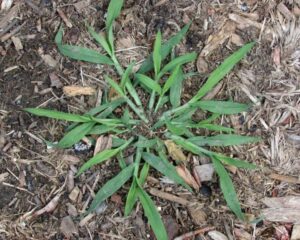What Is Crabgrass
Crabgrass is a type of invasive weed and part of the genus of plants known as Digitaria. These plants are native to temperate regions, but due to their opportunistic nature and resilience, they can also be found in colder climates. Crabgrass seeds spread from blowing in the wind and can go down sidewalks and roads or stay dormant for years. That is, until the perfect combination of water and heat kickstarts the germination process.
Experts agree that crabgrass doesn’t need much water – in fact, it thrives when drought conditions appear and the temperature starts rising. The temperature threshold to kickstart germination is 54-64°F for at least 3-5 consecutive days. A fully matured crabgrass weed can produce thousands of seeds.
You usually have a very small window early in the season to remove crabgrass easily before it grows too sturdy. The two main methods are hand-pulling (using a digging knife or a hand trowel) or crabgrass pre-emergent, a herbicide that prevents crabgrass and most types of weeds from germinating. If the plant has already grown, you will need a crabgrass killer or a post-emergent crabgrass killer.
Why Is Crabgrass Growing In My Lawn?
There are four main reasons why crabgrass may be growing on your lawn. If you take care of all of them, you will notice a significant difference in your lawn every season.
Overly Dry Soil
Crabgrass thrives in warm weather and is very resilient in drought conditions. If you mow your grass too low or too often, you decrease how much water your soil can retain and also make it easier for crabgrass sprouts to reach the sunlight. Additionally, if you water your garden often but too lightly, crabgrass and other weeds that grow near the surface will benefit the most.
Instead, water your lawn deeply 2-3 times every week. Make sure your grass is long enough to both prevent crabgrass saplings from reaching sunlight and shade your soil to increase the amount of water it can retain.
Weak Grass
Sometimes, crabgrass can grab a hold of your lawn because your grass is weak. There are a number of contributing factors; your grass may be weak because it’s overshadowed by trees or bushes and it’s not getting enough sunlight or because it lacks nutrients.
One of the most common reasons for weak grass is dull lawn mower blades. A dull lawn mower is more likely to pull at the entire plant than cut it cleanly; this makes the regrowing process of your grass slower and can create patches, which in turn gives crabgrass and other weeds time and space to start encroaching on your lawn.
Use sharp blades on your lawn mower to ensure all cuts are clean and your grass can regrow as soon as possible.
Soil Compaction
Soil compaction refers to how compact the soil is on your lawn. Very compact soil can keep water and air from reaching the roots of your grass while allowing crabgrass and other superficial weeds to grow, mostly unimpeded.
To avoid this, aerate your lawn in the late summer months and throughout fall. Annual aeration reduces compaction, allows grassroots to receive nutrients, and helps microorganisms oxidize your soil and produce beneficial chemical compounds by mixing oxygen and water.
Correcting The pH Of Your Soil
The ideal pH of your soil for growing grass is between 6.5-7. A too high or too low pH will directly affect how efficiently your grass can absorb nutrients. If your grass is not getting enough nutrients, it won’t grow as fast or as strong and will struggle to keep crabgrass and other weeds at bay.
If your soil is too acidic, the common practice is to apply chemicals that contain lime. Lime is a material that contains calcium and hydroxides that counteract the acidity to achieve a more neutral pH. If, on the other hand, your soil is too basic, common practice is to add elemental sulfur or aluminum sulfate.

When Does Crabgrass Appear?
Crabgrass germinates in central and northern New Jersey in mid to late April. In southern parts of the state, it’s warmer and germinates in early to mid-April. Crabgrass grows until midsummer when the temperatures rise and then shifts into its reproductive stage when the temperature drops. Soon after dropping its seeds – or after a frost -, the crabgrass plant shrivels and dies, leaving behind thousands of seeds.
Crabgrass is an annual weed that completes its life cycle in one season. It produces from 100-800 tillers and over 150,000 seeds, and its seeds stay dormant during the colder months until April the next year, when the water and weather conditions are most favorable.

How To Control Crabgrass?
The best way to control crabgrass is to have strong, healthy grass that can shade out crabgrass completely; this will deny them sunlight, and a properly aerated lawn will ensure your grass receives most of the water and nutrients.
Coupled with this, it’s a very good idea to use a pre-emergent – even one application can do wonders and keep your lawn crabgrass free for the whole season.
At Grasshoppers Landscaping, we offer complete pre-emergent treatment – using the best herbicide for crabgrass – and include multiple applications throughout the season to ensure your lawn stays weed free. We also offer aeration services, so your grass can get all the nutrients it needs, grow strong, and keep annoying weeds at bay. Give us a call, and we’ll give you an estimate for free.


